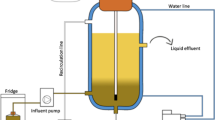Abstract
In this study, the effect of operational parameters, such as solids retention time (SRT), pH, and substrate total solids (TS) concentration, on acid fermentation efficiency was investigated. From batch tests, it was shown that the appropriate pH range for thermophilic acidogens was around 6–7 and that the optimum pH condition was 6. From the continuous experiment, pH and SRT were shown to be the most important operational parameters for solubilization and organic acid production. In contrast, TS concentration did not show any obvious effect on chromium chemical oxygen demand (CODcr) solubilization when TS was in the range 3.5%–10%. The optimum operational conditions for thermophilic acid fermentation were an SRT of 2 days and a pH of 6.
Similar content being viewed by others
References
Imai F, Ukita M, Sekine M, Fukagawa M, Nakanishi H (2000) Fact-finding survey of actual garbage discharged from a dormitory and its biological anaerobic-aerobic treatment. Wat Sci Tech 36:129–135
Hansen K, Angelidaki I, Ahring B (1999) Improving thermophilic anaerobic digestion of swine manure. Wat Res 33:1805–1810
Schaub SM, Leonard JJ (1996) Composting: an alternative waste management option for food processing industries. Trends Food Sci Technol 7(8):263–268
Borup MB, Muchmore DR (1992) Food-processing waste. Wat Environ Res 64(4):413–417
Shin HS, Han SK, Song YC, Lee CY (2001) Food waste treatment using the MUSTAC process. Journal of Korea Society of Waste Management 18:43–50
Li YY, Ko IB, Noike T, Funami K, Sasaki H (2004) Comparison of ammonia inhibition between the mesophilic and thermoph ilic anaerobic digestion of municipal solid waste. In: Proceedings of the 10th World Congress of Anaerobic Digestion. Serge R. Guiot (Congress Chair), Montreal, pp 507–510
Lay JJ, Li YY. Noike T (1997) Influence of pH and moisture content on the methane production in high-solids sludge digestion. Wat Res 31(6):1518–1524
Zhang T, Noike T (1991) Comparison of one-phase and two-phase anaerobic digestion in characteristics of substrate degradation and bacterial population level. Wat Sci Tech 23:1157–1166
Yilmazer G, Yenigün O (1999) Two-phase anaerobic treatment of cheese whey. Wat Sci Tech 40:289–295
Ren N, Wang B, Huang JC (1997) Ethanol-type fermentation from carbohydrate in a high-rate acidogenic reactor. Biotechnol Bioeng 54(5):428–433
Yu HQ, Fang HHP (2003) Acidogenesis of gelatin-rich wastewater in an upflow anaerobic reactor: influence of pH and temperature. Wat Res 37(1):55–66
Guerrero L, Omil F, Méndez R, Lema JM (1999) Anaerobic hydrolysis and acidogenesis of wastewaters from food industries with high content of organic solids and protein. Wat Res 33(15):3281–3290
Veeken A, Hamelers B (1999) Effect of temperature on hydrolysis rate of selected biowaste components. Biores Technol 69:249–254
Bitton G (1994) Wastewater microbiology. Wiley-Liss, New York
Yang K, Yu Y, Hwang S (2003) Selective optimization in thermophilic acidogenesis of cheese-whey wastewater to acetic and butyric acids: partial acidification and methanation. Wat Res 37:2467–2477
Krugel S, Nemeth L, Peddle C (1998) Extended thermophilic anaerobic digestion for producing Class A biosolids at the Greater Vancouver Regional District’s Annacis Island wastewater treatment plant. Wat Sci Technol 38:409–416
Tanigawa N, Takemoto T, Ohki H, Kawasaki T (1997) Detailed components of garbage. J Jpn Waste Manag Assoc 50(217):116–119
Hong F, Tsuno H, Hidaka T, Cheon J (2003) Study on applicability and operation factor of thermophilic methane fermentation to garbage treatment in high concentration under once-a-day feeding condition. Environ Eng Res 40:333–341
APHA, AWWA, WEF (1998) Standard methods for the examination of water and wastewater, 20th edn. Americal Public Health Association, Washington, DC
Dubois M, Gilles K, Hamilton J, Robert P, Smith F (1950) Colorimetric method for determination of sugar and related substances. Anal Chem 28:350–356
Lowry O, Rosebrough N, Farr A, Randall R (1951) Protein measurement with the Folin phenol reagent. J Biol Chem 193:265–275
Noike T, Takabata H, Mizuno O, Ohba M (2002) Inhibition of hydrogen fermentation of organic wastes by lactic acid bacteria. J Hydrogen Energy 27:1367–1371
Author information
Authors and Affiliations
Corresponding author
Additional information
This research was carried as a part of the CREST project of Japan Science and Technology Agency.
Rights and permissions
About this article
Cite this article
Park, YJ., Tsuno, H., Hidaka, T. et al. Evaluation of operational parameters in thermophilic acid fermentation of kitchen waste. J Mater Cycles Waste Manag 10, 46–52 (2008). https://doi.org/10.1007/s10163-007-0184-y
Received:
Accepted:
Published:
Issue Date:
DOI: https://doi.org/10.1007/s10163-007-0184-y




